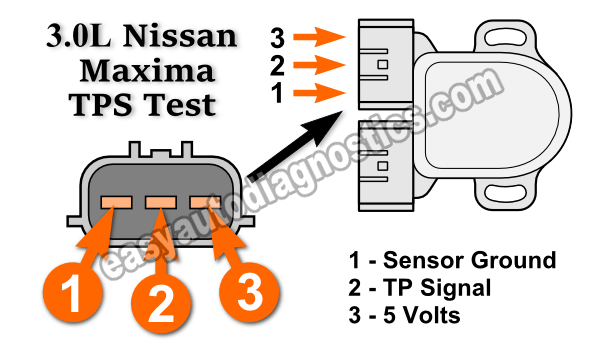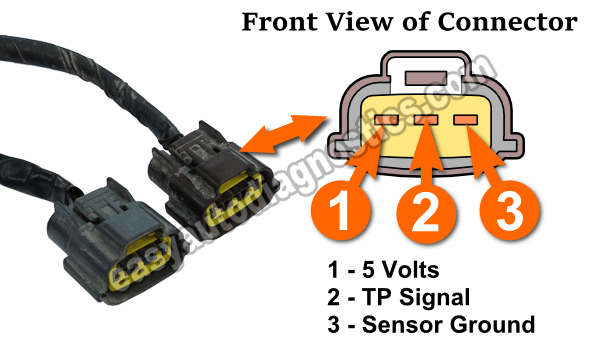
The throttle position sensor on your 3.0L Nissan Maxima (Infiniti I30) can be easily and accurately tested with a simple multimeter. In this tutorial, I'll show you how in a step-by-step way so that you can say 'Yes, the TPS is bad and needs to be replaced' or 'No, the TPS is not bad'.
As you're probably already aware, the throttle position sensor assembly on your 3.0L Nissan Maxima is two sensors in one. One part is the Idle Switch and the other is the Throttle Position Sensor part (that's why the TPS has two connectors). This tutorial focuses on testing the throttle position sensor part only.
NOTE: If you need to test and/or adjust the idle switch part of the throttle position sensor, this tutorial will help: How To Test The Idle Switch (1996-1999 3.0L Maxima).
Contents of this tutorial:
![]() You can find this tutorial in Spanish here: Cómo Probar El Sensor TPS (1996-1999 3.0L Maxima) (at: autotecnico-online.com).
You can find this tutorial in Spanish here: Cómo Probar El Sensor TPS (1996-1999 3.0L Maxima) (at: autotecnico-online.com).
Symptoms Of A Bad Throttle Position Sensor
The throttle position sensor (TPS) is a crucial component of the engine management system on your Nissan Maxima. It's job is to tell the PCM how much the throttle plate opens and closes (as you step on or off the accelerator pedal) so that the PCM can calculate how much more (or less) fuel to inject.
So, when the TPS fails the PCM can not effectively manage the amount of fuel injection (among several things) and you'll one or more of the following symptoms:
- Check engine light (CEL) illuminated on your Maxima's instrument panel.
- A TPS diagnostic trouble code (DTC) stored in the PCM's memory:
- P0120: Throttle Position Sensor Circuit.
- Your 3.0L Nissan Maxima fails the state mandated emissions test.
- Bad gas mileage.
- Hard start and/or extended cranking time (after shut off).
- Black smoke coming out of the tailpipe.
- Hesitation when accelerating your vehicle down the road.
Thankfully, the TPS can be tested without a scan tool and in the next section we'll start with the very first test.
Where To Buy Your TP Sensor And Save
Where can you buy the TP sensor for your 3.0L Nissan? You can buy it at your local auto parts store, but it's gonna' cost a whole lot more. I suggest taking a look at the price of the TP sensor in the following links and compare:
Disclosure: As an Amazon Associate, I earn from qualifying purchases. Buying through these links helps support this site at no extra cost to you. Thanks for your support —it really means a lot!
Not sure if the above TP sensor fits your particular 3.0L Nissan? Don't worry, once you get to the site, they'll make sure it fits by asking you the particulars of your vehicle. If it doesn't fit, they'll find you the right one.
TEST 1: Testing The Throttle Position Sensor Voltage Signal

In a nutshell this is the way the TPS works: The throttle position sensor needs 5 Volts and Ground to produce a throttle angle voltage signal. The exact voltage value, of the throttle angle voltage signal, is a direct result of the movement of the throttle plate since the TPS assembly is mechanically connected to the throttle plate.
To be a bit more specific: The voltage value, of the throttle angle voltage signal, either increases or decreases in direct proportion to the amount the throttle plate opens or closes.
With this bit of knowledge, we're now gonna' verify that the throttle angle voltage increases when we manually open the throttle plate and then decreases back (to its original voltage value) once we close the throttle plate.
NOTE: The throttle position sensor has to remain connected to its brown connector for this test to work (this is where a wire piercing probe comes in handy to get to the signal inside the wire. To see what one looks like, click here: Wire Piercing Probe Tool).
OK, let's start:
PART 1:
- 1
Place your multimeter in Volts DC mode and with the red multimeter test lead probe the middle wire of the sensor's brown connector. This is the wire that connects to pin #2 in the illustration above.
- 2
Ground the black multimeter test lead on the battery negative (-) terminal. Have your helper turn the key ON, but don't start the engine (this will power up the TP sensor).
- 3
Your multimeter should report a voltage between 0.2 to 0.9 Volts DC. If your multimeter doesn't, don't worry about it just yet, continue with the other steps.
PART 2:
- 4
Now, slowly open the throttle (by hand and from the engine compartment) while you observe the change in voltage numbers on your multimeter.
For this test result to be accurate, you need to open the throttle by hand and not from inside the vehicle. - 5
As the throttle opens, the voltage numbers will increase. This increase in voltage should be smooth and without any gaps or skips. Once the throttle is wide open, your multimeter should read somewhere between 3.5 to 4.5 Volts DC.
- 6
Now, slowly close the throttle. As the throttle is closing, you should see the voltage decrease smoothly and without any gaps or skips, to the exact same voltage you noticed in step 4.
PART 3:
- 7
OK, now you'll need someone to help you lightly tap on the throttle position sensor with the handle of a screw-driver (or something similar, and I want to emphasize the words 'lightly tap') as you slowly open and close the throttle and observe the multimeter.
If the TPS is bad, the tapping will cause the voltage numbers to skip or go blank. If the TPS is OK, the tapping will have no effect on the voltage numbers. - 8
Repeat step 7 several times to make sure of your multimeter test results.
Let's take a look at your test results:
CASE 1: The throttle angle voltage increased and decreased as you opened and closed the throttle plate. This test result confirms that the TP sensor is OK and not defective.
CASE 2: The throttle angle voltage DID NOT increase (and/or decrease) as you opened and closed the throttle plate. This test result confirms that the TPS is behind the TPS trouble code lighting up the check engine light (CEL) on your 1996-1999 Nissan Maxima.
I'm gonna' suggest that you make sure that the TP sensor is getting both power and Ground by performing the last two tests in this tutorial. To check that the TPS is getting power, go to: TEST 2: Verifying Throttle Position Sensor Has Power.
CASE 3: The multimeter DID NOT register any voltage. This test result doesn't condemn the TP sensor as bad just yet.
Why? Because the TP sensor may be missing either power or Ground. So the next step is to check that the TP sensor is getting power, go to: TEST 2: Verifying Throttle Position Sensor Has Power.




